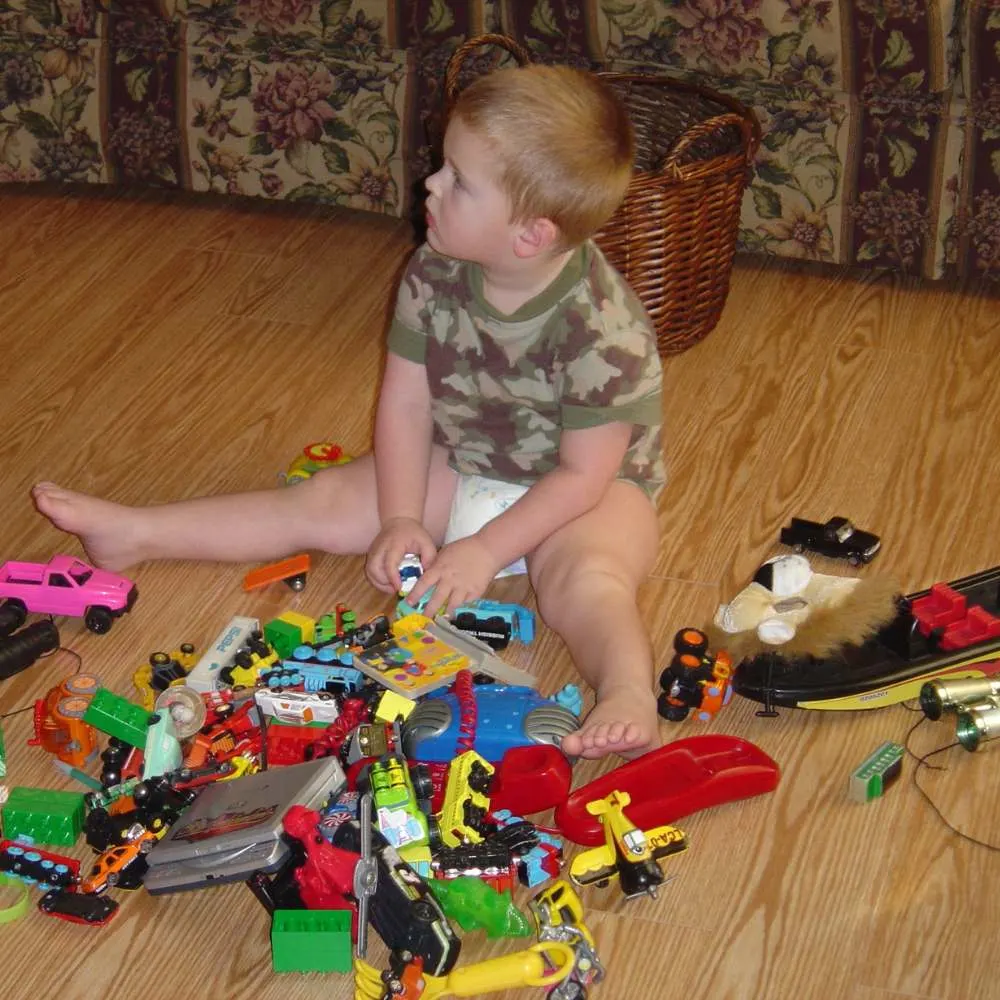- Clay Moon Phase Wall Hanging - July 4, 2023
- What To Do When a Toddler Won’t Keep Their Blanket On - June 10, 2023
- How Do Child Locks Work in Cars? (And When To Use Them!) - June 10, 2023
You’ve bought your toddler a new toy, only to find it on the ground again. It has been a familiar sight since your child became adept at using their hands. Ever wondered why toddlers often throw everything on the ground?
Toddlers throw everything on the ground to see the effects of their actions. Throwing objects is a form of excitement and entertainment for your child. This behavior is typical from 18 months up to three years old.
This article will explain why tossing stuff on the floor is enjoyable for toddlers. You’ll also get some advice on how to make a young child stop the habit of throwing.

Is It Normal for Toddlers To Throw Things?
If you find that your toddler loves pitching their toys across the room, you might be wondering if this is normal behavior. Why do they do this?
Throwing things is normal for toddlers and is considered a developmental milestone. Tossing items is a form of play for children, and play is how they learn best. Toddlers throw objects because they try to engage with things in their vicinity to see what they can do with them.
Children will naturally start to use their hands to handle objects like toys or household items as they grow. When this happens, they actively engage in object-oriented play — toddlers learn to explore and manipulate objects because they want to see what they can do with things and materials (source).
In turn, this leads to toddlers throwing stuff. Between the age of 18 months and three years old, throwing becomes part of their play. While they don’t understand the concept of gravity yet, playing with objects helps them learn what happens when different types of materials hit the ground.
Here are some things your toddler will learn when they throw something on the ground:
- Object permanence
- Fine motor skills
- Hand-eye coordination
- Cause and effect (i.e., “What happens when I throw my toy and it hits the floor?”)
Younger toddlers who cannot speak yet rely on physical actions to communicate with their parents, so throwing an item could indicate that they want your attention.
At What Age Do Toddlers Begin To Throw Things?
Toddlers usually start throwing things at around 12 months old. However, they may not be able to throw them far because they have yet to develop enough strength and control. They become far more adept at throwing stuff when they reach 18 months of age.
For a toddler to be able to grab onto something and hurl it, they will need a certain degree of hand-eye coordination, fine motor skills, and muscle strength. Older toddlers will have more control, so they can throw objects harder and further.
Do Toddlers Throw Things When They Are Angry?
Do flying toys accompany the sound of your child crying? These are signs a toddler is throwing a temper tantrum and using aggressive actions to show that they are upset with something.
Toddlers can throw things when they are angry or upset, just like some toddler-like adults. As young children don’t regulate their emotions well, throwing things can become a way to express their frustration.
In the “terrible twos” stage, kids are most prone to temper tantrums. However, studies have shown that periods of aggression are generally shorter in younger children. Kids tend to quickly outgrow throwing things when they are upset (source).
Getting a Toddler To Stop Throwing Things
While it is normal for toddlers to throw toys around, sometimes they may get too excited and go overboard. When the pitching becomes too frequent or if a family member gets hurt, it’s time for an intervention.
These are some tips for getting your toddler to stop throwing things:
- Give your child lots of attention. Kids love attention — it helps them feel loved and important. Giving your child plenty of undivided attention prevents them from resorting to physical acts to get you to notice them.
- Set rules and boundaries on throwing. Explain to your child what they can and cannot throw. Direct them to a safe space where they can experiment with toys and surfaces.
- Offer them another activity. Children may start throwing stuff when they feel bored. Introducing your toddler to activities such as drawing or clay-making will keep their hands and minds occupied.
- Communicate with your toddler. Communicating calmly will help them understand why their behavior is wrong. Instead of punishing them when they start pitching, explain to them why they shouldn’t be throwing objects.
See my article on What To Do When a Toddler Doesn’t Respond to “No”.
How To Respond When a Toddler Throws Things
The way you react to your toddler pitching things is important. Punishing or strongly reacting to your child’s actions can affect your relationship and the child’s emotional development.
Here’s some advice on how you can respond when your toddler starts throwing things:
- Talk to them patiently.
- Be stern with them, but do not raise your voice.
- Give them age-appropriate safe toys to experiment with throwing.
- Avoid harsh punishments.
- If they hurt someone, help them understand why the behavior is wrong.
Alternatively, you can check out the Montessori method, which has an excellent way of handling excessive throwing behavior.
The Montessori method champions the concept of “freedom within limits,” where as a parent, you offer your child the option of exploring something on their own in a safe, respectful way. For example, instead of throwing a toy truck, allow the toddler to throw stuffed animals.
Final Words
Toddlers throw everything on the ground because this is how they learn the consequences of their actions. A toddler throwing things on the floor is usually to get your attention or to learn about the things around them (i.e., gravity). Throwing can be part of a temper tantrum, but this stage won’t usually last long if the toddler is disciplined appropriately.
Throwing is a normal developmental milestone for children, and it indicates that their cognitive and physical development is progressing well.
Author Notes:
Teresa is a Registered Nurse in the State of Texas and the mother of two. Opinions and insights on childcare are based on professional knowledge, academic research, and personal experience.
Recommended Reading:
- Toddler Keeps Asking To Watch TV? Here’s What To Do
- What To Do When a Toddler Pushes You Away When Crying
Make Your Own Beautiful Living Succulent Wreath Centerpiece! Complete video course by Jeannine Romero now available through Skillshare.
